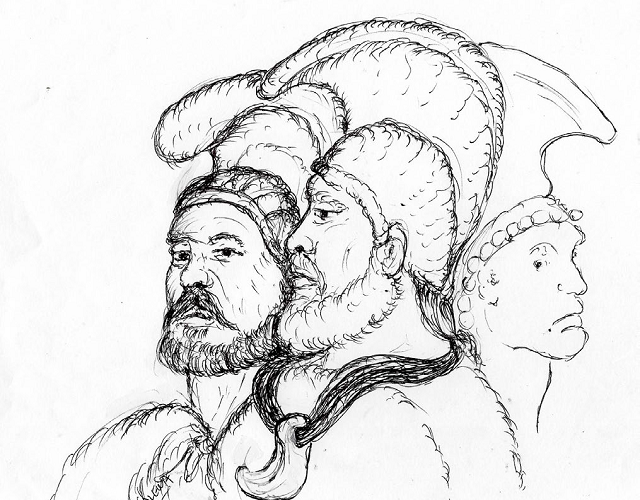Episode four (of six) of the Saga of the North Shore lecture series at the Waialua Library concerned the descendants of the first High Chief to rule this side of Oahu. Maweke made a few round trips between Tahiti and Ewa and is credited with bringing the first breadfruit (ulu) to Oahu. His grandson, Moike`a, also made voyages south and brought back La`amaikahiki, who introduced many of the kapus and restrictions that were to identify Ancient Hawaiian Society. Kaula Kalama was another voyaging chief who ruled near the end of the “Migratory Period”. At that time, rule over Oahu was generally split between two or three high chiefs.
Kumu-Honua was the first chief to unite Oahu under one authority. His son, Haka, was such a poor ruler that no-one came to his defense when the other chiefs revolted and executed him. They elected a fellow named Mailikukahi as “Moi” to oversee all of Oahu. Of interest is that he had been born at Kukaneloko and his inaugural ceremonies were held at Kapukapuakea (Kaiaka Park). He ruled from Waikiki and abolished the acts of human sacrifice on Oahu. It was during his time that a large company of warriors from the Big Island attacked the Ewa beaches and marched inland. The Oahu forces met them on the central plains and defeated them with such slaughter that Kipapa Gulch was named for the fact that the stream bed was paved with the bodies of the slain.
Next to rule was Kalona, then Piliwale. His daughter, Kukaneloko, was the first woman elected as Moi of Oahu, followed by her daughter Kalaimanuia. It was during her time that many fishponds were built in Pearl Harbor. Her eldest son, Kuamanuia, was Moi for a short time before being murdered by his brother while building another fishpond. Kukuhihewa followed. His grand court is still recalled in tradition and chant. He was famous for gathering the very best craftsmen and artists of the islands. His three sons got along well enough to fend off an attack on Waikiki from Maui. A daughter, Kekela ruled Waialua and Waianae. The youngest son, Hao, was living lavishly at Waikele, when he was murdered by his brother. Hao’s son ran to Kauai for a while, but came back to marry Kekela and share the north-western lands with her.
The next high chiefs were Kahoowahaokalani, then Kauakahi. This was the time that the prostrating kapu was installed, demanding that the general population kneel before the Ali`i. The rule of Oahu had become fractured again, until united by Kuali`i. This was about the year 1700. Kuali`i had family connections on Kauai and went there to arm his soldiers with the best wood for spears. After two bloody battles, Oahu was under his rule. He went off to subjugate Molokai and raid Hilo and was about to attack Puna when word came of a rebellion at Waialua. He returned to settle that before taking a voyage that may have taken him to Acapulco aboard a Manila Galleon. He returned to live on Oahu to a very old age. There is a very long and famous chant about Kuali`i’s life and times.
His son, Kapilo Hookalani, heard that Molokai was in rebellion so he took the Oahu Army there. That got the attention of a Maui warlord named Alapai-nui, who took the side of the Molokai chiefs. A five-day battle followed during which the Oahu chiefs were nearly wiped out. A young boy of high rank was elected Moi. Alapai-nui saw an opportunity and invaded Oahu. Another of Kualii’s sons, Peleioholani, was ruling the southern half of Kauai at the time. He sailed to the defense of Oahu and came to a truce with Alapai-nui. He was in turn elected Moi of Oahu, as the young boy had died. Peleioholani’s daughter had married a Molokai chief who abused and killed her. That was cause for another subjection of Molokai, which held until a later wave of warfare from Maui.
His son, Kumahana, was an indolent fool who was deposed and sent off to Kauai. The best candidate for Moiship was a young Ewa chief of the Maweke-Kalona line named Kahahana. He was on Maui, being raised in the court of Kahekili.
Kahikili consented to allowing Kahahana to rule Oahu so long as he received the sacred lands of Kualoa and all the whale ivory that had washed ashore on Oahu. Some of the chiefs and priests accepted the demands, but the highest priest, Kaopulupulu, who hailed from Waimea Valley, was absolutely opposed to such a high price. The bill was not paid. Kahekili bided his time and spread rumors of disloyalty about Kaopulupulu, who soon found his council ignored. He retired to the North Shore and had all the people tattoo their knees in protest.
That was the beginning of the end of Oahu’s sovereignty, which we shall discuss on July 14.


